By V. Shourabh
Sculptors are creative visual artists who, with their imagination, take various materials, which they then carve, chisel and model to make a finished sculptural work of art. A Sculptors’ Camp with the theme “Ancient Indian Sculptural Art” was organised from Nov. 8 to Nov. 23 at Manasagangothri campus. This Weekend Star Supplement profiles the artisans who tirelessly toiled at the camp to create masterpieces.
Chiselling wonders with hands
India, definitely being the land of temples and architecture, has caved in a huge room for sculptors since ages. The art, which requires exquisite skill and patience, is not just engraved on rocks or wood. It is engraved in the pages of Indian History depicting different civilisations and umpteen mythological stories.
Sculptures form the core in religion in many cultures and civilisations. From using cave wall carvings for communication to modern art of stone sculpting, mankind has made rapid strides. Sculpting turns a lifeless rock into an exquisite ‘Vigraha’ (idol) and a beholder feels that a sense of supreme power resides in the idol that has inspired the artist to bring out for the whole world to see.
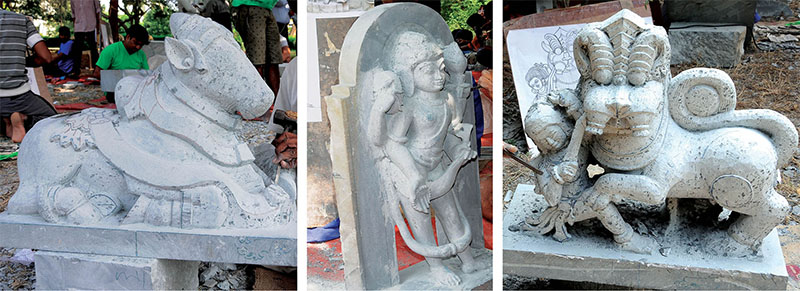
In the so called modern era, traditional practices are, however, on the verge of decline. To save this extraordinary art, there are several institutions and universities desperately trying to revive and rejuvenate the art of sculpting aiming to infuse life into rocks to mark the re-emergence of sculpting as a dominant art form.
With one such motive, Lalit Kala Akademi, National Academy of Art, New Delhi and the University of Mysore had organised a Sculptors’ Camp with the theme – “Ancient Indian Sculptural Art” from Nov. 8 to Nov. 23 at Manasagangothri.
The camp had ten sculptors from various parts of Karnataka and the team was headed by Puttaswamy Gudigar, Director, Shilpaloka, Verna, Goa. These sculptors carved their art in soapstone, depicting traditional dynastic styles. Persistent knocking, proper application of pressure, accurate chiselling and cutting of edges are vital in getting the stone to shape and for the final image to emerge. Giving life to the rocks is no child’s play.
While the sculptors carved stories on stones, SOM explored the stories of those Sculptors. Stories that have been chiselled by passion, driven by tradition and that has a journey to trace.
- Santosh Badiger
Santosh Badiger has earned himself the post of Assistant Director for Shilpaloka with his fine carving and chiselling techniques which he has mastered over the years. Hailing from Shirgod in Hangal Taluk, Haveri District, Karnataka, he was born to a family of Vishwakarmas whose traditional occupation was carpentry.
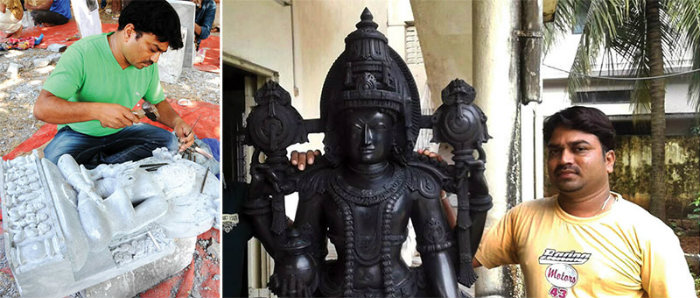
His cousins and family members who were in the field of sculpting influenced him. His carving techniques are exquisite as he is trained in wood and stone carving under the tutelage of G.L. Bhat at K.P.J. Prabhu Artisans Training Centre, Bidadi.
He is an experienced sculptor who has been working in this field for the past 17 years. He has been an active sculptor at various institutions in Bengaluru, Bidadi, Kudal, Kalaghatagi and Goa. His major works include wooden sculpture of Govardhanagiri (six feet) and Dhanvanthri in stone (6.5 feet). He has sculpted a Sarnath Buddha during the camp that concluded in Mysuru on Nov.23.
- Siddalingayya Kalmata
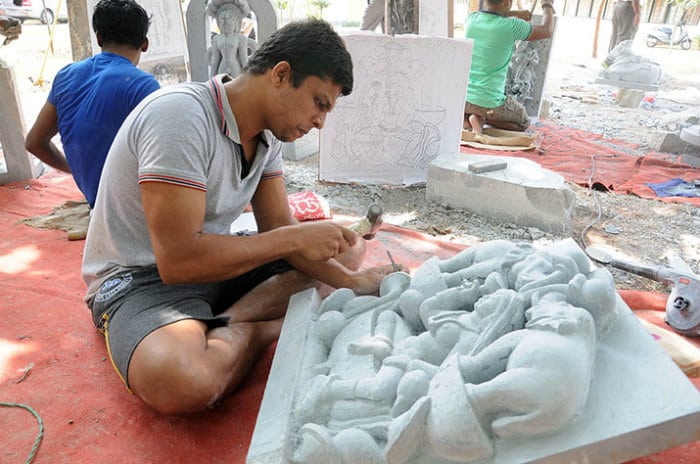
Siddalingayya Kalmata is a sculptor known for his expertise in carving and hails from Hospet in Bellary district. He was born to a family of Jangamas. He is also an ITI graduate and is trained in stone and wood carving at K.P.J. Prabhu Artisans Training Centre, Jogerdoodi, Bidadi and in wood carving at Shilpa Gurukula, Sagara, under the guidance Vipin Singh Badauria.
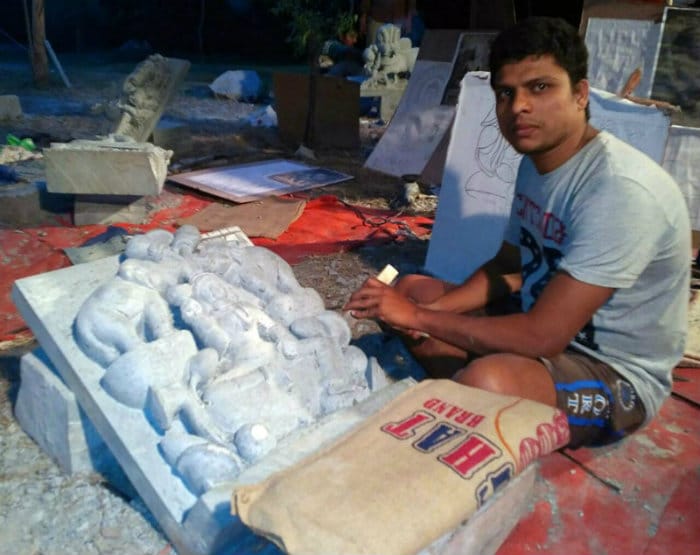
Later, he received training under Suresh Gudigar at Bidadi School. He has been working in Shilpaloka, Goa, since the past three years. In this camp, he has sculpted a Gajalakshmi- Sanchi Stupa.
- Mounesh G. Kammar
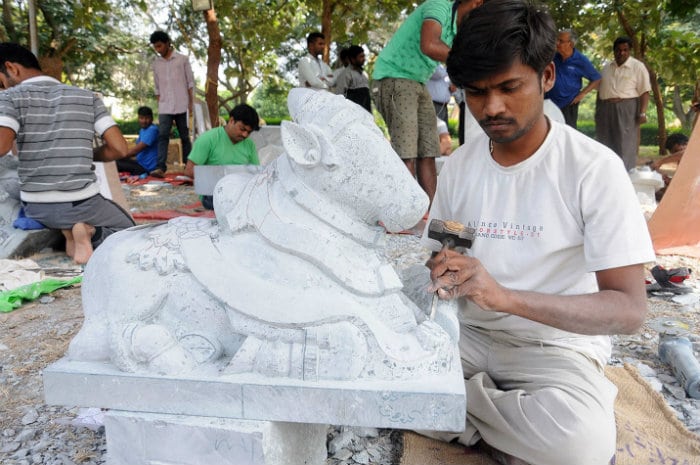
Mounesh G. Kammar belongs to a family of agriculturists of Vishwakarma clan in the village of Upper Nandihal in Lingsugur taluk, Raichur district. He received his training in sculpting from Vishwanath Achar at Gangarasa Shilpakala Kendra, Kengal, Channapattana. He is skilled in stone carving and has an experience of 5 years in stone sculpting with Nagaraj Kammar and in Shilpaloka, Goa. His famous works include images of Gajalakshmi, Nandi and Ganesha in stone. In this camp, he has sculpted a statue of Nandi the bull in Hoysala style.
- Sunil Gangadhar Kammar
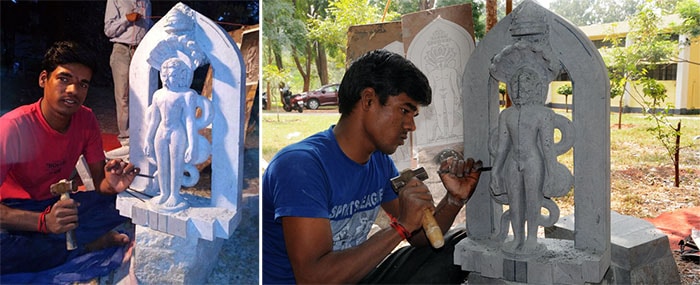
Sunil Gangadhar Kammar hails from Attangi village in Mundgod taluk. He belongs to Vishwakarma family whose occupation is black smith and carpentry. He got his basic skill training at Shilpa Gurukula at Sagara from Vipin Singh Badauria. He is well versed with his skill in both wood and stone carving which he honed during his stint as a sculptor at Shilpaloka in Goa. He has carved the sculptures of Krishna- Hoysala, Ganesha, Nandi, seven-headed Devi, Lakshmi, etc. At the Mysuru camp, he sculpted a Pashuvanath sculpture of the Chalukya Dynasty.
- Nagaraj R. Badiger
Nagaraj R. Badiger was passionate about being a sculptor since his childhood. That passion has brought him a long way in the art of making sculptures. He hails from Vishwakarma family in the village of Koujageri in Ron Taluk, Gadag district.
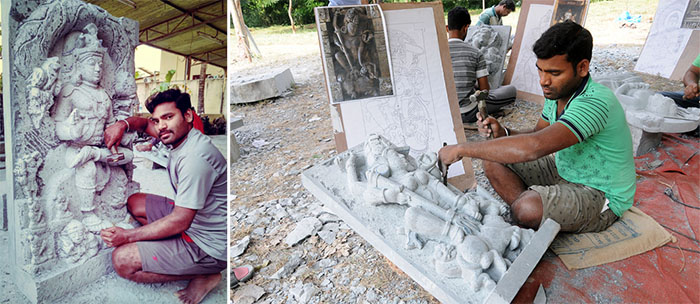
Carpentry has been a traditional family occupation of Vishwakarmas. Umesh Gudigar and Nagesh Achar gave him the essential training at K.P.J. Artisans Training Centre at Bidadi. He has been working as a sculptor at Shilpaloka, Goa, for about 6 years. His masterpieces include a stone Dakshinamurthy (4.5 feet), Hanuman, Durga and Rameshwara. He sculpted a Chamunda from the Pratihara period at the camp in Mysuru.
- Chandrakant Basappa Kammar
Chandrakant Basappa Kammar belongs to Palikoppa village in Hubballi taluk in Dharwad district. He also came into this field as he hailed from the Vishwakarma family. He received training from G.L. Bhat at Bidadi School for two years.
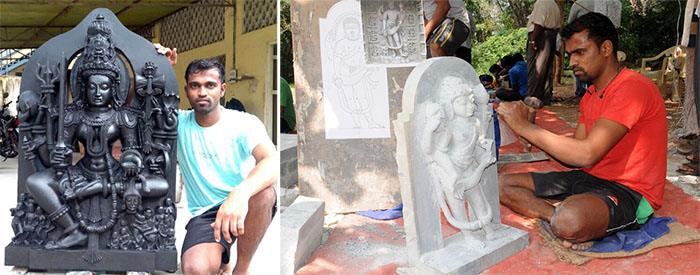
Chandrakant also has an experience of four years at Shilpaloka where he has carved the sculptures of Yama and Nachiketha, Vishnu worshipping Shiva, Vishwakarma, and Hoysala-Ganesha. He sculpted a Buddha avatar (Bodhisattva) of the Solanki Period during the sculptors’ camp in Mysuru.
- Prakash A. Harmannavar
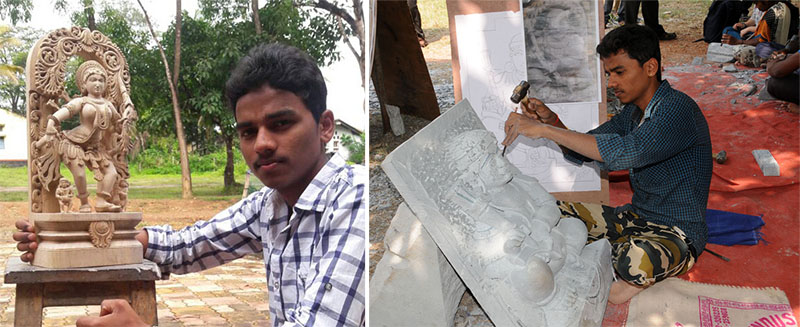
Prakash A. Harmannavar comes from Junjunbail village in Kalaghatagi taluk, Dharwad district. Unlike others in his family who pursued agriculture, Prakash developed an interest towards sculpting after he completed his college. He received training in wood and stone carving from Vipin Singh Badauria in Shilpa Gurukula in Sagara, Shivamogga district. He has also participated in the wooden sculpture camp that was organised by the Dasara Committee celebration in Mysuru in 2017. Prakash chiselled a Somanathapura Yaksha Shilpa (sculpture) during the Mysuru camp.
- Jayachandra
Jayachandra hails from Beltangady taluk in Dakshina Kannada district. He has been trained at C.E. Kamath Institute of Artisans at Miyar in Karkala, in wood and stone carving. He says, “I have no family influence in sculpting. Rather I got inspired by one of my relatives who was working in the same field. That was when I made up my mind that I should achieve something and move ahead in this field.”
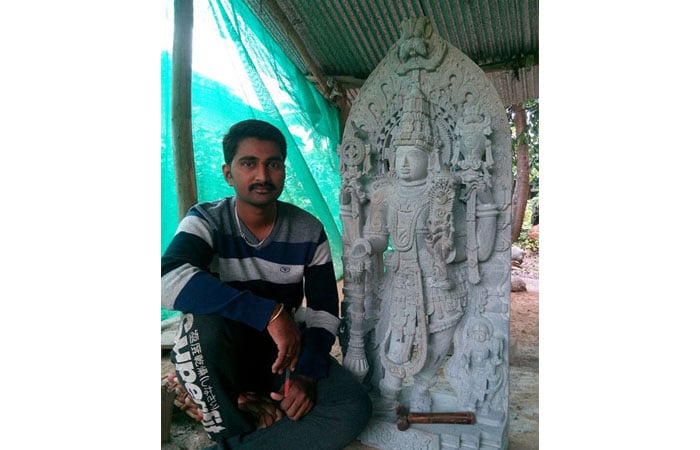
He has worked at Kudal and received special training in Sandal woodcraft at Shilpa Gurukula at Sagara. He has participated in camps at Surapura where he carved a Channakeshava idol in Hoysala style. At the wooden sculpture camp at Siddapura, where he carved a Harihara image in Chalukya style.
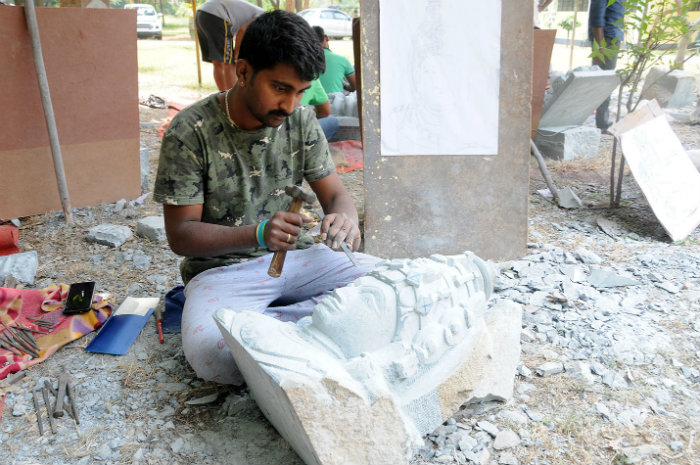
He was also a part of the wooden sculpture camp held in Mysuru recently. His major works include stone sculptures of Darpanasundari, Karthikeya, Hoysala Nandi, Hoysala face and Anjaneya and wooden sculptures of peacock and lion. He is currently working at K.P.J. Prabhu Artisans Training Centre, Bidadi. He has sculpted the Sun God’s face (Surya) in Chalukya style at the Mysuru camp.
- Sandeep Naik
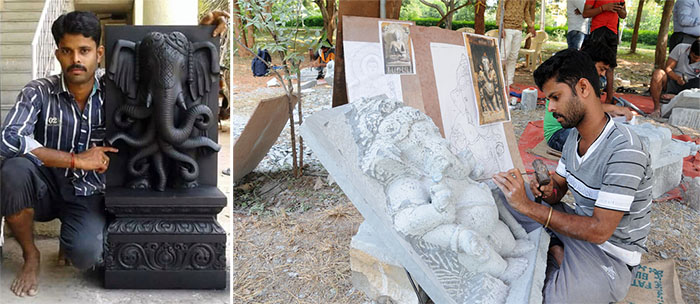
Sandeep Naik hails from a family filled with agriculturists in Mundgod village in Honnavar taluk, Uttara Kannada district. He received training from G.L. Bhat and Venkataramana Bhat in Bengaluru. He has been working as a sculptor at Shilpaloka, Goa, since 4 years. His major works include Hanuman (4.5 feet), Ganapathi – Chandela style, Kaliamardhana, Rama and Airavata. He has sculpted a Chandela-style Ganapathi at the Mysuru camp.
- Shashikumar Acharya
Shashikumar Acharya is a sculptor from the Dakshina Kannada district. He is a graduate in Visual Arts and received basic training in wood and stone sculpting at C.E. Kamath Institute of Artisans, Miyar at Karkala. He obtained advanced training at Brahmarshi Shilpa Gurukula in Chikkaballapura.
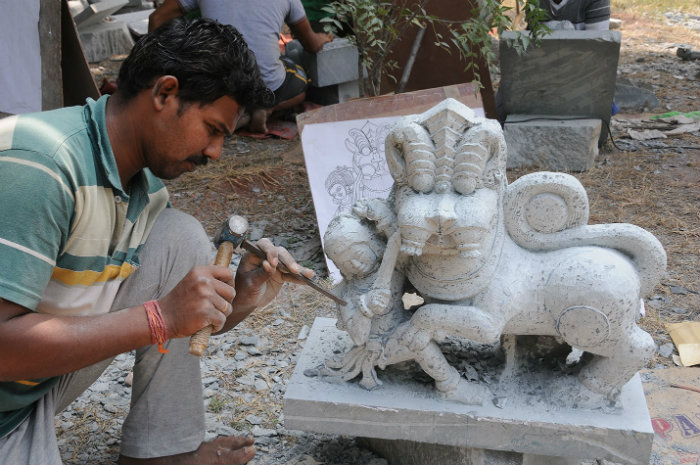
He has participated in camps at Bengaluru, Kodak, Hampi and Dharwad where he has carved sculptures in ancient styles. He developed a taste towards sculpting as his family was also into sculpting. He was always fascinated by Indian temples and the carvings on them.
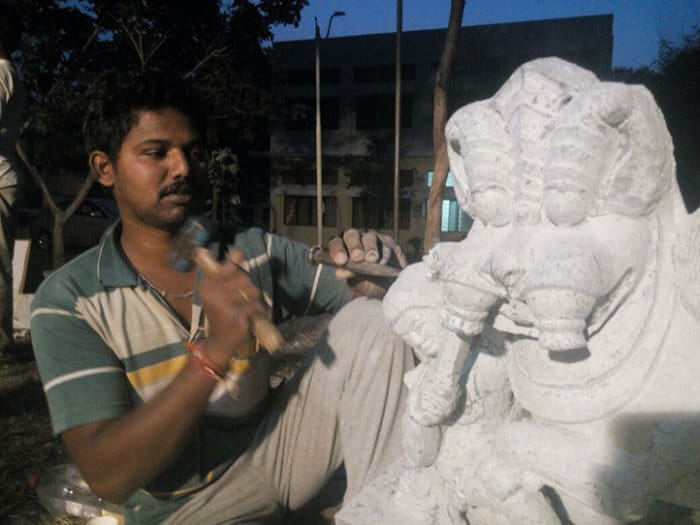
His masterpieces include Hoysala Ganapathi and Varaha in stone, wooden Horse and Garuda. With an experience of 4 years at C.E. Kamath Institute with Sheshappa Acharya, Shashikumar is now an independent sculptor based in Mangaluru. He sculpted an emblem of Hoysala Dynasty at the sculptors’ camp in Mysuru.
Puttaswamy Gudigar
Puttaswamy Gudigar hails from a family of traditional sculptors and artists in Sagara (Shivamogga District in Karnataka). He developed a taste for sculpting at a young age which he got from his father Gudigar Chikkanna and practiced those skills.
After completing his B.A. at Maharaja’s College, Mysuru and M.A. in Ancient History and Archaeology in Manasagangothri, he became a Marine Archaeologist and served the National Institute of Oceanography for two decades. He dedicated twenty years of his life to science as an underwater diver-archaeologist. There, he participated in underwater explorations and excavations in the waters at Dwaraka, Mahabalipuram, Poompuhar, Nagapattinam, Lakshadweep and Goa.
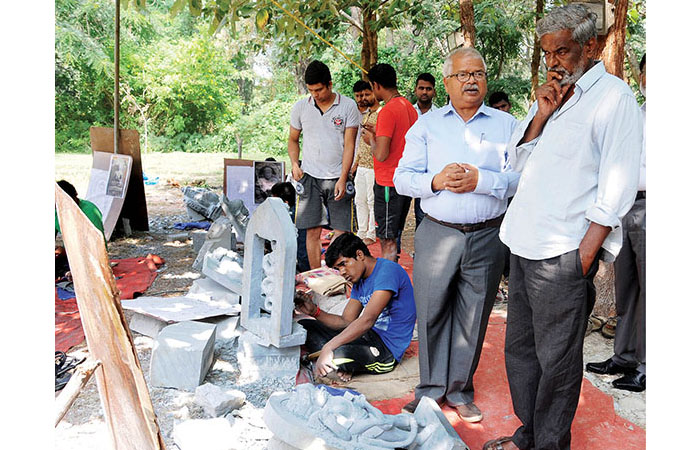
Puttaswamy Gudigar, Director, Shilpaloka, Verna, Goa, who oversaw the sculptors camp at Manasagangothri, seen with Kannada litterateur and social activist Devanur Mahadeva.
Diving deep under water exploring ocean wealth, one day it dawned upon him that he has to pursue his family tradition. More than realising, passion pulled him into sculpting. From underwater job to a hard-core job on terra-firma – the transformation was complete.
He took voluntary retirement and started Shilpaloka, a training institute in Goa where young artists receive training in sculpting. His vision is to revive traditional sculpting art in the modern era. He is a recipient of Karnataka Rajyotsava Award (2012) and Shilparatnakara Prashasti (2010).
Vijay Rao
Vijay Rao, Head of the Department, Art History, Chamarajendra Academy of Visual Arts (CAVA), Mysuru was one of the chief guests for the inaugural function of this camp. He was of the opinion that there is an aesthetic experience in making sculptures. He says, “Skill and imagination are both vital to make sculptures and one needs to form an imagination till it turns into an image, and that image should be sculpted on a stone, metal or wood.”
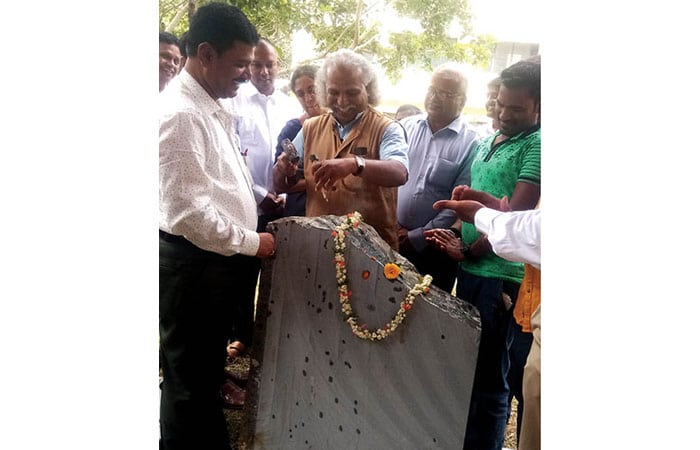
Vijay Rao, Head of the Department, Art History, Chamarajendra Academy of Visual Arts, tries his hands at sculpting.
He believes that the sculptures give a sense of inner force in the soul that helps us meditate and evokes a sense of peace within the body. According to Vijay Rao, three elements are catalysts to feel the power that turns a stone into a Vigraha – Sankalpa, Prathista and Aarohana.
He highlighted that making sculptures is all about giving life to an image and it depends on the sculptor to give emotions to it. He quotes, “Sculptures elevate souls to the heaven and they also bring heaven down to earth.”
CONCLUSION:
Sculpture making is nothing new in Indian mythological history. If we take a leap back into the mythological era, sculpting dates back to the birth of Lord Ganesha. That was the very first incident of sculpting something in the human form. Goddess Parvathi had appointed Nandi (her husband Shiva’s bull) to guard the door while she prepares for her bath. However, when Lord Shiva arrived, Nandi let him pass through. In order to have someone loyal to her, Parvathi used turmeric from her body and sculpted a human form and breathed life into it. That was how Lord Ganesha was born. Thus, every sculpture has a story within itself in a solid form and the sculptor gives it a climax frame that describes its emotions and idealises the concept, all on a single solid piece of rock.



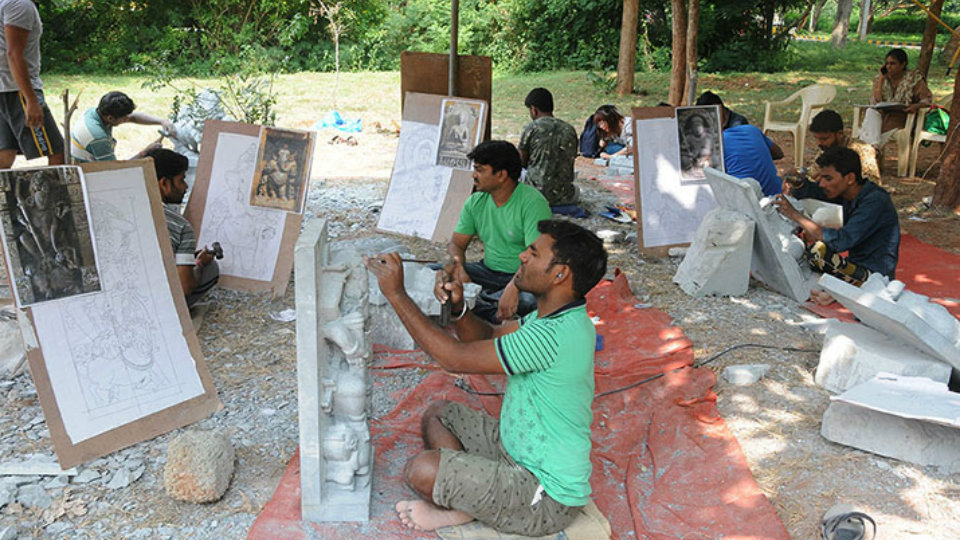
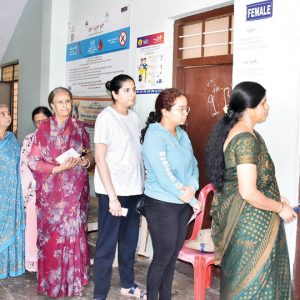
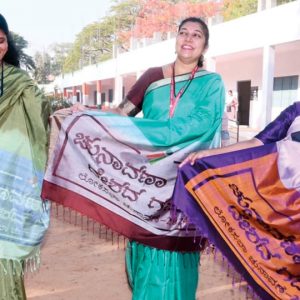
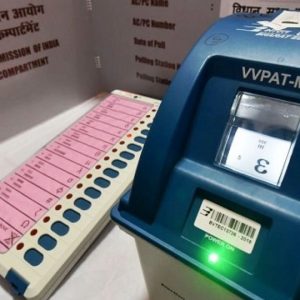
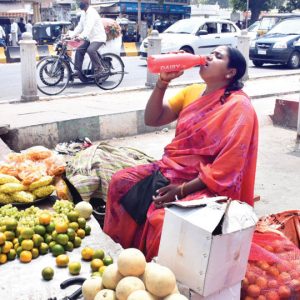
Recent Comments